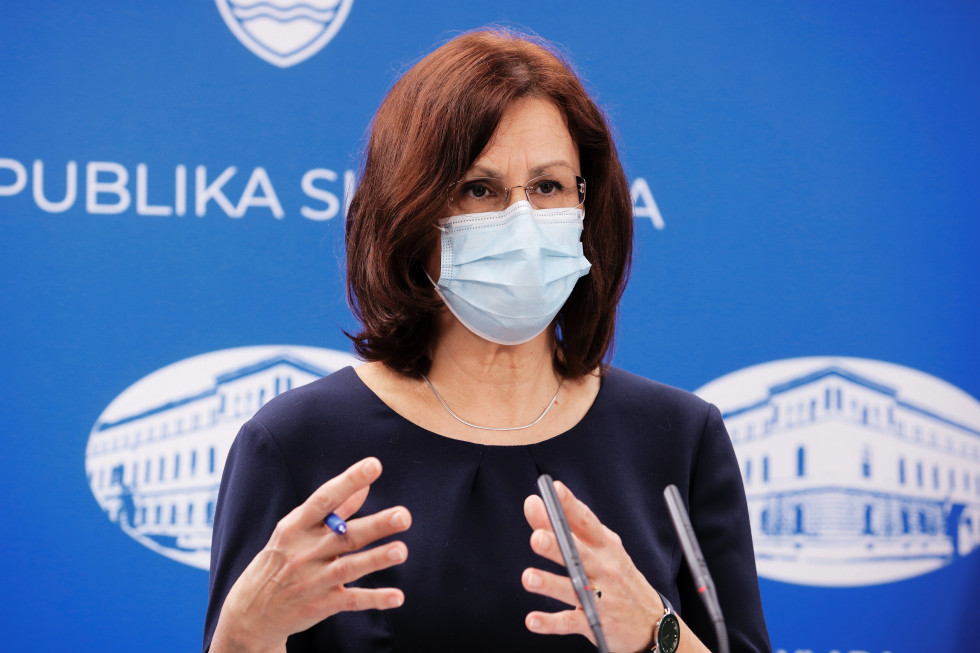By: gov.si
Yesterday’s press conference on the current COVID-19 situation was attended by the State Secretary at the Ministry of Health, Marija Magajne, the Director of the National Laboratory of Health, Environment and Food, Tjaša Žohar Čretnik, a paediatrician at the Division of Paediatrics of the Ljubljana University Medical Centre, Tadej Avčin, and Mojca Juriševič from the Department of fundamental pedagogical studies at the Faculty of Education in Ljubljana.
On Monday, a public holiday, only 1,493 PCR tests were conducted, of which 204 or 13.7% were positive. Among 9,760 rapid tests, 153 or 1.6% were positive.
The number of active positive coronavirus cases is decreasing and is currently at 14,437. The 14-day incidence rate has also been decreasing for some time now and currently amounts to 682 cases.
A total of 945 patients are currently in hospitals, of whom 162 require intensive care. On Monday, 19 deaths were recorded, of which 18 were in hospitals and one in a home for the elderly.
Taking yesterday’s data into account, the seven-day average of confirmed cases has decreased to 842 and is now below 1,000, as is the number of hospitalised patients, which, according to the roadmap for easing measures, means a transition to the orange phase.
Automatic confirmation of positive rapid tests with the PCR method will also be implemented in Slovenia as soon as the epidemiological situation improves even further, said Marija Magajne. In the current phase of the epidemic, it is for the epidemiologist and personal doctor of the person concerned to decide whether to confirm positive rapid tests with the PCR method. In the event of many positive rapid tests at a time, it is generally decided to confirm them with PCR testing, while in the event of individual positive tests, the epidemiologist conducts an epidemiological investigation and the doctor examines the symptoms characteristic for COVID-19. Based on this, they decide whether or not to confirm a positive rapid test.
This week, the Ministry of Health is expecting a delivery of rapid tests from the joint European Union procurement. Five per cent of all tests delivered will be free of charge, while the rest will be paid by Slovenia, though the price has not yet been made public. Rapid tests are also being implemented by certain testing providers, who purchase their own tests. The ministry is still deciding on a new national tender.
The results of confirming the UK strain of the virus by using the sequencing method on 16 coronavirus samples confirmed with PCR testing did not show the presence of the UK strain in those samples. Only four cases of the UK strain have therefore been confirmed in Slovenia based on other tests.
The national laboratory continues to perform testing using the Slovak test. Every tenth positive PCR sample will be analysed by PCR testing and the sequencing method. The sequencing of samples analysed in the laboratories of the National Laboratory of Health, Environment and Food will be carried out in collaboration with the Ljubljana University Medical Centre. On Friday, they sent them the first 600 samples that were found positive by the classic PCR testing.
According to the analysis of the National Laboratory of Health, Environment and Food, the Majbert Pharm rapid tests have proven to be specific enough in all three groups (i.e. the symptomatic group, the asymptomatic group and the entire group of examinees), taking into account the national guidelines and the guidelines of the World Health Organisation (WHO).
Concerning the sensitivity, the test meets the requirements of the World Health Organisation for the entire group of examinees, while it meets the requirements of the national recommendations for both the symptomatic and asymptomatic groups of examinees among which the virus is widespread.
The guidelines of the European Centre for Disease Prevention and Control (ECDC) and thus the national guidelines are based on the WHO guidelines. Particular attention is given to the sensitivity level, which should be brought as close to 90% as possible according to the ECDC recommendations.
Tjaša Žohar Čretnik believes that purchasing the Majbert Pharm test was not a bad decision, therefore a new tender could include similar requirements.
According to Tadej Avčin, the two most frequent conditions diagnosed in children at the Division of Paediatrics are multisystem inflammatory syndrome and small-vessel vasculitis. Sars-Cov-2 has several ways of activating the immune system. Firstly, it can cause a sudden and extremely severe immune cell activation. Secondly, the virus itself can cause tissue damage, which can lead to necrosis and inflammation. Thirdly, during the transcription of the virus’s genetic material, proteins that are incompatible with the individual’s own proteins are produced, which causes the production of autoantibodies.
Within 7–10 days of introducing treatment, the inflammation indicators generally subside and, on average, children can be discharged from the hospital after 14 days. The effect on the heart is also important, as well as medication that alleviates the strain. The inflammation was successfully reduced in all the treated children. The final situation will be clear after 6 months, when MRIs and assessment of cognitive functions such as memory and attention and concentration deficits are carried out.
According to Mojca Juriševič, children and adolescents have suffered from a loss of motivation due to the lack of social relations that are usually constantly provided in school. Particularly in childhood and adolescence, social relations are essential for a healthy personal and educational development. They have short-term and long-term effects. Other important factors causing a lack of motivation are also uncertainty, change in routines and well-being, and worries related to the epidemic, which shift the focus from studying for various reasons such as loss of a loved one, stress on the parents, their upcoming matura exam and other extraordinary events.
The epidemic and related measures are no longer a short-term state, as was expected during the first wave; they are rather becoming part of our everyday lives and are thus no longer as interesting as in the beginning, when closing down schools posed a challenge. Such long-term schooling from home prevents children and adolescents from satisfying their physical and psychological developmental needs. It seems that, gradually, differences between pupils are increasing significantly due to different conditions for schooling from home, which will require assessing and remedying after they return to school.


